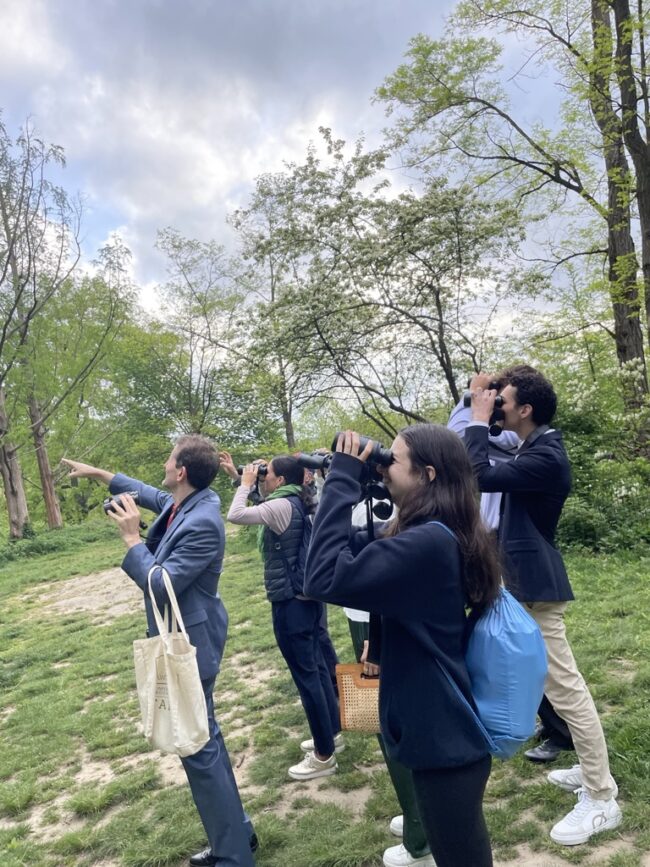Editors’ Note: All photo credits go to the author, Lily Saal
Before Fieldston’s annual Founder’s Day, a group of teachers and students took part in a tradition that goes back more than 40 years: a bird walk through Central Park. Led by Howie Waldman, the science research teacher who is Fieldson’s “green dean,” the birders met at 7 am on 72nd and Central Park West, received a brief introduction and spent two hours seeking, listening to and spotting a stunning variety of birds.
Waldman continues the work of Peter Mott, retired Fieldston bio teacher and first official “green dean” at Fieldston, who started the Fieldston Founder’s Day Birdwalk in the 1970s. Waldman, who worked closely with Mott, reflected on their time together: “We set up feeders in the wintertime and counted the different numbers of species that came. Mott had great records of tropical birds on campus. I still have those spreadsheets.”
In his school-wide email inviting participation on the walk, Waldman wrote, “This message is dedicated to my friend and mentor, Peter Mott, who started this tradition.”
“This message is dedicated to my friend and mentor, Peter Mott, who started this tradition.”
Birdwalk Leader Howie Waldman
On a chilly, cloudy May 3rd morning, group members trickled into the park’s entrance, some in their classy Founder’s Day outfits and some in casual clothes (or ordinary school clothing). Through yawns and eye rubs, everyone introduced themselves.
The small group included only 7 students: Diana Bienstock, Yadna Prasad, Ellie Usdin, Hannah Saez-Zadoff, Lorenzo Cohen, Liam Katzin and myself. Two other teachers joined: Biology teacher Rebecca Beaton and English teacher Michael Morse, an experienced birder who shared that he almost became an ornithologist, a scientist who studies birds. Lucky for Fieldston’s English department, Morse decided to read poems about birds – not study them.
Waldman handed out binoculars, referred to as “bins,” and quickly explained the walk: In spurts of 300, neotropical birds use Central Park as a rest stop as they continue migrating north. The birds in the park constantly change, something, Waldman commented, “really shows us the informality of life.”
Some years the Fieldston birdwalkers have seen 75 different species, some years less than 20. To Waldman, it doesn’t matter. He referred to his fellow passionate birdwatchers when he shared, “If you’re like us, you’ll love seeing a cardinal, which is as common as they come.”
“If you’re like us, you’ll love seeing a cardinal, which is as common as they come.”
Birdwalk Leader Howie Waldman
The group did spy a couple of Cardinals, whose bright red bodies made them one of the easiest birds to spot. Some birds like the American Robin, crept close to the group, allowing for some close-up photos. Others like the Scarlet Tanager, one of the rarest birds to spot because it likes to stay high in trees, only allowed a lucky few to catch a glimpse.
The Fieldston group linked up with a professional birdwatching tour as both stood together, attempting to spot the Scarlet Tanager. More than a dozen pairs of binoculars pointed up and shouted directions. After a few exclamations of, “I saw it!” The groups joyfully parted ways, proud of their rare spotting.
In total, the Fieldston group spotted/heard the following species:
Northern Flicker, Redbelly Woodpecker, Scarlet Tanager, Ovenbird, Hermit Thrush, Common Grackle, White Throated Sparrow, House Sparrow, Northern Cardinal, Black and White Warbler, Common Yellow Throat Warbler, Cormorant, Blue Jay, Northern Parallel Warbler, Magnolia Warbler, Rock dove, Cardinal, American Robin, Eastern Towhee and Pigeon
The walk wound through and around dusty, trodden paths hidden in the park, commercial spaces (like the iconic Central Park loop) and breathtaking bodies of water, which remained quite still in the early morning. At one point, Ellie Usdin (Form V) wondered aloud, “What if someone made a pop song out of bird noises?” Waldman, ready as always, quickly brought up Olivier Messiaen, a composer of bird noises. To identify different noises Waldman and Morse used the Merlin App (run by the Cornell Lab), which listens to different birdsongs, records them and shows a photo of the birds singing. Without missing a beat, Usdin commented, “It’s Shazam for birds.”
The question asked by everyone (including probably Felix Adler had he attended his celebratory event): Why on EARTH would you wake up SO early to birdwalk? Everyone had a different answer: Yadna Prasad (Form VI) explained, “I always kinda wanted to do it.” they trailed off and smiled, “But the early mornings.” Prasad decided to join the 2024 walk because, as a senior, it’s their final opportunity to do so. Underclassmen with years of possible bird walks lying ahead had different reasonings. Hannah Saez-Zadoff (Form IV) wanted to “be in the park early in the morning to get some fresh air, especially before sitting in a stuffy auditorium.” Usdin, a first-time bird walker, explained her motivation succinctly: “We’re here for a good time not a long time.”
“We’re here for a good time not a long time.”
Ellie Usdin (Form V)
Beyond birds, we spotted classic NYC things: litter, wedding photos, lots of runners (including Form V Fieldston track star Owen Larson getting his run in before the event) and, hilariously, a naked man bathing in Central Park’s pond.
Sometimes when the group got distracted, Waldman would recenter us. He would stop, hold his hand up, and say, “Just listen.” Some closed their eyes as the tweets and chirps of the birds floated around us.
Group member Katzin described the walk best: “When I heard about the bird walk, it was an instant ‘yes’ from me. When else do you get to wake up at 5:30 am to follow two passionate, amateur ornithologists around Central Park birding for 2.5 hours?”
An unforgettable, unique and completely Fieldston experience – somewhere, Felix Adler and Peter Mott are cheering for these enthusiastic birders.






